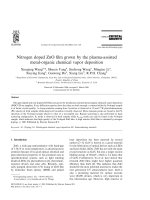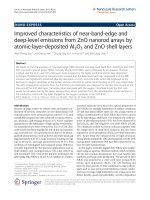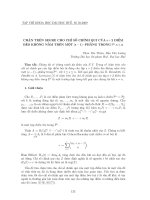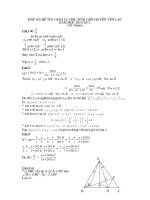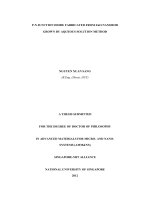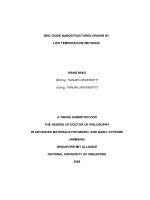p n junction diode fabricated from zno nanorod grown by aqueous solution method
Bạn đang xem bản rút gọn của tài liệu. Xem và tải ngay bản đầy đủ của tài liệu tại đây (18.85 MB, 131 trang )
P-N JUNCTION DIODE FABRICATED FROM ZnO NANOROD
GROWN BY AQUEOUS SOLUTION METHOD
NGUYEN XUAN SANG
(B.Eng. (Hons), HUT)
A THESIS SUBMITTED
FOR THE DEGREE OF DOCTOR OF PHILOSOPHY
IN ADVANCED MATERIALS FOR MICRO- AND NANO-
SYSTEMS (AMM&NS)
SINGAPORE-MIT ALLIANCE
NATIONAL UNIVERSITY OF SINGAPORE
2012
DECLARATION
I hereby declare that this thesis is my original work
and it has been written by me in its entirety.
I have duly acknowledged all the sources of
information which have been used in the thesis.
This thesis has also not been submitted for any
degree in any university previously
_____________________
Nguyen Xuan Sang
15 August 2012
i
Acknowledgements
First of all, I would like to express my sincere appreciation to my
supervisors, Prof. Chua Soo Jin and Prof. Eugene A. Fitzgerald for their
guidance and support me throughout my PhD study. Their advices and
supporting has been invaluable on both academic and personal level, for
which I am extremely grateful.
I would like to express my thanks to Dr. Tay Chuan Beng for his
helping and guiding me from first step of my research work. His important
suggestions help me not only in my PhD research but also in my future work. I
would like to thank Dr. Le Hong Quang and Dr. Soh Chew Beng from IMRE
for their helps my research.
Great acknowledgment to Ms. Musni and Mr. Tan from Center for
Optoelectronics, NUS, their experience and skill helped me in lab equipments
and experiments. I would like to thanks Dr. Huang Xiaohu, Mr. Zhang Chen,
and Ms. Tang Jie for their help in doing some of my research work. I also
would like to give thanks to Ms. Doreen for SEM measurements, Mr. Eric
TANG and Ms. TEO Siew Lang for photolithography, RIE and e-beam
evaporator experiments in IMRE.
I would like to thank Prof. Choi wee Kiong, Ms. Hong Yanling, and
Ms. Juliana Chai from Singapore – MIT Alliance program for their
administrative support during my PhD. Great thanks to Singapore – MIT
Alliance program for financial support.
Finally, I would like to give my special thanks to my parents, my wife,
my son and my brothers, sister. Their support and love enable me to go
through the hard time and complete this work.
ii
TABLE OF CONTENTS
Acknowledgments………………………… ………………………………….i
Summary………………………………………………………………… …vi
List of Tables……………………………………………………………… viii
List of Figures…………………………………………………………… …ix
Chapter 1 Introduction………………………………………….… ………1
1.1 Background and basic properties of ZnO……………….…………………1
1.1.1 Background………………………….…………………… … 1
1.1.2 Basic properties of ZnO…………………………………… ….2
1.2 ZnO nanorods growth technique …………………………… …….…….5
1.2.1 Vapor phase methods………………………………… ….……5
1.2.2 Solution method………………………………………… ….…7
1.3 Doping ZnO nanorods ……………………………… ………………… 9
1.3.1 Doping n-type ZnO………………………… ………………….9
1.3.2 Doping p-type ZnO………………………… …………… …11
1.4 Application of ZnO in solid state lighting……………… …………… 13
1.4.1 ZnO based heterojunction LED………………….…… ………13
1.4.2 ZnO based homojunction LED……………………… ….… 16
1.5 Motivation of the thesis………………………………………….….… 19
1.6 Organization of the thesis…………………… ………………….…… 20
Chapter 2 Experiment setup and characterization methods 22
2.1 Growth procedure……………………………………………………… 22
2.1.1 Aqueous solution growth procedure of ZnO nanorods ……… 22
2.1.2 Reactions of the solution growth……………………………….23
2.1.3 Effect of pH on ZnO surface…………… …………………….26
2.1.4 Nucleation and growth……………………….…………… …28
iii
2.2 LED fabrication equipments………………………….…….……………30
2.2.1 RIE system ………………………………………………… 30
2.2.2 Photolithography system…………………………… ……… 31
2.2.3 E-beam evaporator……………………………………… ……32
2.3 Characterization equipments………………………………… ……… 32
2.3.1 Microscopes……………………………………………………33
2.3.2 Photoluminescence and electroluminescence…………… … 34
2.3.3 XPS and SIMS…………………………………………….… 36
2.3.4 I-V and C-V…………………………………………………….38
2.4 Conclusions………………………………………………………………38
Chapter 3 Optimization of the growth and post-treatment of n-ZnO
nanorods………………………………………………………………….….40
3.1. Morphology of n-type ZnO nanorods ……………………………… …40
3.1.1 ZnO nanorods growth precursor……………………………….40
3.1.2 Morphology of undoped ZnO nanorods…………………….….41
3.1.3 Morphology of ZnO nanorods doped with Ga and Al……… 42
3.1.4 Discussion on growth habit of Ga and Al-doped nanorods… 47
3.2. Characterization of undoped ZnO Nanorods ………………….……….50
3.2.1 X-Ray Diffraction analysis…………………………………… 50
3.2.2 Transmission electron microscope (TEM) measurement………51
3.2.3 SIMS analysis………………………………………………… 52
3.2.4 Energy-dispersive X-ray spectroscopy (EDX)………….… …53
3.2.5 XPS analysis……………………………………….………… 54
3. 3 Optical properties of ZnO nanorods………………………….………….55
3.3.1 Photoluminescence of undoped ZnO nanorods ……………… 56
3.3.2 Photoluminescence of Al and Ga doped ZnO nanorods…….…57
3.3.3 Photoluminescence of undoped ZnO nanorods after annealing 58
iv
3.4 Conclusions ……………………………………………… …… …59
Chapter 4 Optimization of p-type ZnO nanorods growth by doping with
potassium using aqueous solution method……………… ….60
4.1 Principle of doping potassium for p-type ZnO …………………… … 60
4.1.1 Motivation for use of potassium as p-type acceptor dopants in
ZnO……………………………………………………………………… …60
4.1.2 Type and Nature of Potassium Defect in ZnO…………… ….62
4.2 Properties of p-type ZnO nanorod ……………………………………….63
4.2.1 Morphology ……………………………………………………63
4.2.2 Lattice structure of p-type ZnO nanorods…………… …64
4.2.3 Chemical composition of p-type ZnO nanorods……………….65
4.2.4 Electrical properties of p-type ZnO nanorods…………………71
4.2.5 Optical properties of p-type ZnO nanorods: Photoluminescenc.72
4.3 Improving the quality of p-type ZnO nanorods by of annealing……… 73
4.3.1 Optical properties of p-type ZnO nanorods after heat-
treatment…………………………………………………………… 73
4.3.2 Energy level of defects by low temperature PL of p-type ZnO
nanorods……………………………………………………… 74
4.4 Conclusions……………………………………………………… 75
Chapter 5 Fabrication of p- type ZnO nanorods/n-GaN film hetero-
junction ultraviolet light emitting diodes by aqueous solution method 77
5.1. Fabrication of p- type ZnO nanorods/n-GaN film hetero-junction LED 77
5.2 Electrical properties of the p-type ZnO nanorods/n-GaN film LED…….79
5.3 Optical properties of the p-type ZnO nanorods/n-GaN film LED……….81
5.3.1 Electroluminescence of the p-type ZnO nanorods/n-GaN film
LED………………………………………………………………… 81
5.3.2 Comparison of electroluminescence of the p-type ZnO
nanorods/n-GaN film LED and p-ZnO film/n-GaN film LED………85
5.4 Conclusions…………………………………………………… …… …85
Chapter 6 Fabrication of ZnO coaxial nanorods homojunction on GaN
substrates……………………………………………………………… 87
v
6.1 LED fabrication process………………………… ………… ….…… 87
6.2 Morphology of the ZnO homojunctions…………………….……… …88
6.3 Electrical properties of coaxial ZnO nanorods homojunction……… ….89
6.3.1 Investigate the n- and p- contacts in the LED……………… 89
6.3.2 Electrical properties of coaxial ZnO nanorods homojunction…91
6.4 Optical properties of coaxial ZnO nanorods homojunction…………… 94
6.5 Study the degradation of the ZnO homo-junction………………….……96
6.6 Conclusion…………………………………………… …96
Chapter 7 Conclusions and recommendations……………….……… ….98
7.1 Conclusions…………………………………………… ……… 98
7.2 Recommendations……………………………………… ……… 100
Bibliography……………………………………………….…… …… …103
Biography………………………………………………… ……………….113
Publication list……………………………………………….…….…… 114
Awards & Honors……………………………………………………… 115
vi
Summary
The growth of n- type and p-type ZnO nanorods using aqueous
solution method is the first part of this work. n-type ZnO nanorods were
obtained either by unintentional doped or doping with group III elements. p-
type ZnO nanorods were obtained by doping with potassium. The ZnO
nanorods were vertically aligned on GaN substrates. The undoped ZnO
nanorods are n-type semiconductor that has the electron concentration of
about 5x10
17
cm
-3
. P-type ZnO doped at 0.07M KAc have hole concentration
of about 2x10
17
cm
-3
. Characterizations using X-ray photoelectron
spectroscopy (XPS) and Secondary Ion Mass Spectroscopy (SIMS) show that
the undoped ZnO nanorods are highly purity and have the Zn/O ratio of about
50:50. The similar characterization of p-type ZnO shows the existence of
potassium along the p-type ZnO nanorods. Photoluminescence (PL)
measurements of n-type and p-type ZnO nanorods were conducted to show the
near band-edge emission at 370nm and impurity centers emission in visible
range. Heat-treatment at 450°C was applied to improve the near band-edge PL
emission of the n-type and p-type ZnO nanorods by three orders of
magnitudes.
Using p-type ZnO nanorods growth technique, we fabricated a p-type
ZnO nanorod/n-GaN film heterojunction ultraviolet LED. The LED
demonstrates a rectifying I-V characteristic with a turn-on voltage of 2.7 V
and a reverse bias leakage current of 10
-6
A at 5V. Ideality factor, which was
calculated from ln(I)-V characteristic, is 6.5. The existence of interface
charges in the ZnO/GaN interface is the main cause for the low turn-on
voltage and high ideality factor of the heterojunction. Electroluminescence
vii
(EL) spectra of the LED were obtained at room temperature consists of an
ultraviolet peak at 378 nm and a broad yellow emission centered at 560nm.
Fitting and comparing EL of the LED with PL of p-ZnO and n-GaN show that
p-ZnO contributes more to the EL than n-GaN.
Finally, we have demonstrated the fabrication of a ZnO nanorod core-
shell homojunction UV LED. The ZnO homojunction demonstrates a
rectifying I-V characteristic with a turn-on voltage of 3.35V and an ideality
factor of 22.1 in the voltage range of 3.5 to 5.0 V. The p-doped and undoped
nanorods have hole and electron concentrations of 2 x 10
17
and 5 x 10
17
cm
-3
respectively as determined from a good fit of the I-V characteristics with the
simulation results obtained by TMA MEDICI. These values agree well with
those obtained from Hall measurement of similarly doped films. Room
temperature EL spectra consist of an ultraviolet peak at 372nm and a broad
visible peak centered at 560nm. A red shift was observed in the UV EL peak
at higher applied currents. Comparison between the EL and PL spectra of the
ZnO homojunction and GaN substrate confirms that the light is emitted from
the ZnO homojunction. The stability of the LED was demonstrated for
duration of three weeks after storage in normal ambient conditions.
viii
LIST OF TABLES
Table 1.1 Summary of electron concentration levels of unintentional doped
ZnO grown using various methods…………………………… ……… ….10
Table 1.2 Summary of various group III elements as well as their
corresponding growth methods and levels of n-doping… ……………….…11
Table 1.3 Calculated nearest-neighbor bond lengths and the defect energy
levels for negatively charged substitution impurities… ……………………11
Table 1.4 Summary of p-type ZnO using group V elements dopants……….12
Table 1.5 Survey of structure, method, and emission color of ZnO based
heterojunction LEDs………………………………………………… … …14
Table 1.6 Structure, the growth method and the emission peak position of
ZnO nanostructures based hererojunction LEDs………………………… 15
Table 1.7 Structure, the growth method and the emission peak position of
ZnO homojunction LEDs…………………………………………… 18
Table 4.1 Calculated nearest-neighbor bond lengths and the defect energy
levels for negatively charged substitution impurities…………………… ….61
Table 4.2 Quantitative calculation of all elements in p-type ZnO nanorods at
500°C…………………………………………………… ………………… 68
Table 4.3 Summary of measured Hall effect carrier concentrations for
undoped and potassium doped ZnO films. A positive and negative sign
indicates hole and electron concentration per cm
-3
respectively………….….72
Table 5.1 Turn-on voltage and ideality factor of p-ZnO nanorods/n-GaN film
I-V characteristics at different ammonia concentration ……….………….…80
Table 6.1 Summary of reported values of turn-on voltages and ideality factors
for ZnO and GaN homojunctions………………………………………… 93
ix
LIST OF FIGURES
Figure 1.1: Unit cell of the crystal structure of ZnO……… ……………….03
Figure 1.2 Scanning electron microscopy (SEM) images of ZnO combs
formed by evaporating ZnO powder at 1400°C for 2 hours. (a) Low-
magnification SEM image of ZnO combs. (b) High-magnification SEM image
of a comb made of an array of rectangular ZnO nanobelts ~400 nm wide at a
spacing of ~700 nm. (c) Array of nanobelts ~280 nm wide at a spacing of
~250 nm. Upper right inset shows the growth front of one rectangular
nanobelt. Scale bar = 500 nm. Lower left inset is an SEM image of the stem of
a comb. Scale bar = 10 µm. (d) Aligned nanobelts ~500 nm wide at a spacing
of ~300 nm. Inset is the growth front of a nanobelt. Scale bar = 500
nm…………………… …………… ………………… …………………04
Figure 1.3 A few examples of ZnO nanorods and tetrapods. From Sauer and
Thonke (a), Waag (b), Grund- mann (c), and Wissinger (d)…………………05
Figure 1.4 Schematic showing the free energy of the precursors in gaseous
and hydrated states and the final ZnO product…… ………………….…… 09
Figure 1.5 Zinc oxide homostructural p–i–n junction shows
electroluminescence (EL) in forward bias at room-temperature.
Electroluminescence spectrum from the p–i–n junction (blue) and
photoluminescence (PL) spectrum of a p-type ZnO fi lm measured at 300 K.
The p–i–n junction was operated by feeding in a direct current of 20
mA………………………………………………………………… …….….17
Figure 2.1 Schematic of ZnO growth by aqueous solution method…………23
Figure 2.2 Hydrolysis of hydrated Zn
2+
metal ions in aqueous solution. The
circle labeled M is Zn ………………………………………………… …24
Figure 2.3 The ionic equilibrium of Zn
2+
in aqueous solution at 90°C …… 25
Figure 2.4 A model for adsorption of Zn
2+
on ZnO surface…………………27
Figure 2.5 The dependence of adsorption of Zn
2+
ions on the pH of the growth
solution……………………………………………………………………….27
Figure 2.6 Processes involved in heterogeneous nucleation on a substrate
surface……………………………………………………………………… 28
Figure 2.7 (a) A diagram of a RIE setup. An RIE consists of two electrodes (1
and 4) that create an electric field (3) meant to accelerate ions (2) toward the
surface of the samples (5). (b)The front view of the Oxford Plasma 80 RIE
system………………………………………………………………… …….30
Figure 2.8 An example of pattern sample using AZ 5214 (a) and front view of
the SUSS Mask Aligner system (b)…………………………………….…….31
x
Figure 2.9 Typical Process Recipe of the SUSS Mask aligner………… …31
Figure 2.10 Electron beam source and Edwards Auto306 E-beam evaporation
system……………………………… ……………… ……… ……………32
Figure 2.11 (a) Electron beam in SEM and (b) the JEOL FESEM 6700 system
in IMRE…………………………………………… …………… …………33
Figure 2.12 Front view of JEOL 2000V TEM system. ……………….…….34
Figure 2.13 Renishaw 2000 Raman/PL microscope set up………………….35
Figure 2.14 The electroluminescence measurement by probe under photo-
detector……………………………………………………………………….36
Figure 2.15 Principle of XPS analysis system………………………………37
Figure 2.16 Schematic diagram of the SIMS process……………….………38
Figure 2.17 Set up of I-V and C-V measurement system……………… …38
Figure 3.1 SEM images of ZnO nanorods grown at (a) 0.18, (b) 0.36 M and
(c) 0.54 M NH
4
OH. The concentration of ZnAc
2
, growth temperature and
duration were kept constant at 0.01 M, 90°C and 1 h respectively ………….41
Figure 3.2 SEM images showing the morphology and area density of ZnO
nanorods for (a) 0.01, (b) 0.02 and (c) 0.03 M of ZnAc
2
. The concentration of
NH
4
OH, growth temperature and duration were kept constant at 0.37 M
respectively………………………………………………………………………… 42
Figure 3.3 Morphology of ZnO:Ga using (a) 0, (b) 0.02, (c) 0.08 and (d) 0.20
mM Ga(NO
3
)
3
. The concentration of ZnAc
2
, NH
4
OH, growth temperature and
duration are kept constant at 0.01 M, 0.37 M, 90°C and 1h. Cross-sectional
SEM images of corresponding ZnO:Ga using (e) 0.02 mM and (f) 0.20mM 44
Figure 3.4 Effect of doping Ga(NO
3
)
3
on the morphology of ZnO grown on
GaN substrate with (a) 0.18 M NH
4
OH, (b) 0.37 M NH
4
OH, and (c) 0.54 M
NH
4
OH……………………………………………………………………… 45
Figure 3.5 Morphology of ZnO:Al nanorods grown with (a) 0, (b) 5 and (c)
10 mM AlCl
3
. The concentrations of ZnAc
2
, NH
4
OH, growth temperatures
and durations were kept constant at 0.1 M, 0.37 M, 90°C and 1 h
respectively………………………………………………………………… 46
Figure 3.6 Cross-sectional SEM images of ZnO nanorods grown with (a) 0.18
M, (b) 0.37 M and (c) 0.55 M NH
4
OH. The concentrations of ZnAc
2
, AlCl
3
,
growth temperatures and durations were kept constant at 0.01M, 5 mM, 90°C
and 1 h…………………………………………………………………………………47
Figure 3.7 Schematic diagram summarizing the changes in ZnO growth habit
in the presence of varying concentrations of Ga(NO
3
)
3
and AlCl
3
dopant
salts………………………………………………………………………… 47
xi
Figure 3.8 Schematic diagram summarizing the factors affecting the growth
habit of ZnO in the presence of Ga(NO
3
)
3
and AlCl
3
dopant salts.………….48
Figure 3.9 XRD of ZnO nanorods growth on GaN substrate. The growth
condition is 0.01M ZnAc, 0.37 M NH
4
OH. The red lines are standard position
of ZnO bulk…… 51
Figure 3.10 The (a) low and (b) high resolution TEM images of ZnO
nanorods grown in the solution consisting of 0.01 M ZnAc
2
, 0.37 M NH
4
OH
at 90°C for 1 h…… 52
Figure 3.11 SIMS depth profile of of ZnO nanorods grown on GaN substrate
using 0.01 M ZnAc
2
and 0.37 M NH
4
OH at 90°C for 1 h. ………………….53
Figure 3.12 EDX spectrum of ZnO nanorods grown on Si substrate using 0.01
M ZnAc
2
and 0.37 M NH
4
OH at 90°C for 1 h…………………………….…53
Figure 3.13 XPS spectrum of ZnO nanorods grown on GaN substrate, the
growth condition is 0.2g ZnAc
2
, 1.2ml NH
3
, 1 hour and 90°C. ………… …54
Figure 3.14 The XPS spectrum of Zn 2p
1/2
and Zn 2p
3/2
peaks from ZnO
nanorods grown on GaN substrate in 0.02 M ZnAc
2
and 0.37 M NH
4
OH at
90°C for 1 h……………………………………………………………… …55
Figure 3.15 The XPS spectrum of O 1s peak from ZnO nanorods grown on
GaN substrate in 0.02 M ZnAc
2
and 0.37 M NH
4
OH at 90°C for 1 h…….…55
Figure 3.16 Photoluminescence of ZnO nanorods grown at (a) 0.54 M (b)
0.37 M, and (c) 0.18 M NH
4
OH. The other growth parameters are
concentration of ZnAc
2
, growth temperature and duration were kept constant
at 0.01 M, 90°C and 1 h.………………………………………………….….57
Figure 3.17 Photoluminescence of (a) un-doped, (b) 10 mM AlCl
3
and (c)
0.08 mM Ga(NO
3
)
3
doped ZnO nanorods. The other growth parameters are
concentration of ZnAc
2
, NH
4
OH, growth temperature and duration were kept
constant at 0.01 M, 0.37M, 90°C and 1 h………………………………… 58
Figure 3.18 Photoluminescence of un-doped ZnO nanorods annealed at
different temperatures, varying from 200°C to 600°C. The anneal time is 30
minutes. The growth parameters are concentration of ZnAc
2
, NH
4
OH, growth
temperature and duration were kept constant at 0.01 M, 0.37M, 90°C and
1h…………………………………………………………………………… 59
Figure 4.1 Schematic diagram showing the simulated lattice structure of ZnO
(a) without any complexes, (b) with K
Zn
-H
i
and (c) K
Zn
-K
i
complexes.… …63
Figure 4.2 The SEM images of ZnO:K nanorods grown at (a) 0.00, (b) 0.07,
and (c) 0.15 M KAc. Concentration of ZnAc
2
, NH
4
OH, growth temperature
and duration are kept constant at 0.01 M, 0.37 M respectively at 90°C for 1
h…………………………………………………………………………… 64
xii
Figure 4.3 (a) HRTEM of ZnO nanorods grown in 0.01 M ZnAc
2
, 0.15M
NH
4
OH and 0.07 M KAc. The white spot represent the oxygen atoms. (b)
SAED image of the same ZnO nanorod. …………………………………….65
Figure 4.4 ToF-SIMS of ZnO:K nanorods on n-GaN substrate showing
incorporation of K ……………………………… …………….……………66
Figure 4.5 ToF-SIMS mapping image of p-type ZnO nanorods………….…67
Figure 4.6 XPS spectra of the ZnO nanorods growth in aqueous solution
includes: 0.01 M ZnAc
2
, 0.07MKAc and 0.37 M NH
4
OH. The measured
temperatures are (a) 25 and (b) 500°C…………………………………… 67
Figure 4.7 XPS spectra of the K 2p peaks of ZnO nanorods growth in aqueous
solution includes: 0.01 M ZnAc
2
, 0.07MKAc and 0.37 M NH
4
OH. The
measured temperatures are (a) 25 and (b) 500°C……………………………68
Figure 4.8 XPS spectra of the O 1s peaks of ZnO nanorods growth in aqueous
solution includes: 0.01 M ZnAc
2
, 0.07MKAc and 0.37 M NH
4
OH. The
measured temperatures are (a) 25 and (b) 500°C…………………………….69
Figure 4.9 XPS spectra of the Zn 2p peaks of ZnO nanorods growth in
aqueous solution includes: 0.01 M ZnAc
2
, 0.07MKAc and 0.37 M NH
4
OH.
The measured temperatures are (a) 25 and (b) 500°C……………………… 70
Figure 4.10 (a) Raman scattering spectra of p-type ZnO nanorods at room
temperature and (b) plot of peak positions of A
1
-LO against the concentration
of KAc for as-grown samples A, B, C, D and E which are grown in 0, 0.03,
0.08, 0.13 and 0.18 M KAc respectively. The inset of (b) shows the fitted
components consisting of the A
1
-LO peak and its surface mode for sample
C…………………………………………………………………………… 71
Figure 4.11 Room temperature photoluminescence of potassium doped ZnO
at different doping concentration vary from 0.00 to 0.13M KAc. The other
parameters are ZnAc
2
, NH
4
OH concentration; growth temperature and
duration are 0.01M, 0.37M, 90°C and 1 h, respectively…………………… 73
Figure 4.12 Low-temperature (16K) photoluminescence of potassium doped
ZnO annealed at different temperature. The ZnO: K nanorods were grown in
aqueous solution contain 0.01 M ZnAc
2
, 0.07 M KAc, 0.18 M NH
4
OH at
90°C for 1 h…………… 74
Figure 4.13 Normalized low temperature (16K) photoluminescence of
potassium doped ZnO annealed 700°C for 30 minutes, inset is band diagram
of potassium doped ZnO…… ……………………………… …………… 75
Figure 5.1 Fabrication process of p-ZnO nanorods/ n-GaN film heterojunction
LED… ……………………………………………………….…….……….78
Figure 5.2 Comparison of the experiment and simulated I-V characteristic of
p-ZnO nanorods/n-GaN films heterojunction, the simulation was performed
xiii
by using TMA MEDICI software with the hole and electron concentration of
3× 10
17
and 5×10
17
cm
-3
, respectively. The inset shows I–V characteristic of
(a) n-metal/n-GaN contact, (b) p-ZnO/p-metal contact…………………… 79
Figure 5.3 Electroluminescence spectra of p-ZnO nanorods/n-GaN film LED
at difference applied current.………………………….………….………….82
Figure 5.4 Fitting of electroluminescence spectra of p-ZnO nanorods/n-GaN
film LED at difference applied current to investigate effect of thermal heating
on peak position. Temperatures of the device are estimated…………………83
Figure 5.5 Normalized PL spectra of p-type ZnO nanorods, n-GaN film and
EL spectrum of p-ZnO nanorods/n-GaN film hererojunction LED.…………84
Figure 6.1 Fabrication process of coaxial ZnO nanorod homojunction
LED………………………………………………………………………… 88
Figure 6.2 (a) SEM images showing the exposed tips of the un-doped ZnO
nanorods covered in photo-resist (0.02 ZnAc
2
with 0.37M NH
4
OH, 1h, 90
o
C)
after dry etching in O
2
plasma (100W) for 11 minutes and (b) corresponding
ZnO core-shell homonjunction grown in solution containing 0.02 M ZnAc
2
and 0.37M NH
4
OH for the core layer while the shell layer nanorod is grown
with 0.02 M ZnAc
2
, 0.370 M NH
4
OH and 0.07 M KAc. The photoresist has
been removed ………………………………………………….………… 89
Figure 6.3 I-V characteristic of (a) n-metal/n-GaN contact, (b) n-GaN/n-ZnO
junction and (c) p-ZnO/p-metal contact.………………………………….….90
Figure 6.4 (a) SEM cross-sectional image of p-type ZnO grown on
unintentionally doped GaN epi-layer. The p-ZnO was grown using two growth
cycles, where each growth cycle consists of an aqueous solution of 0.02 M
ZnAc
2
, 0.37 M NH
4
OH and 0.07 M KAc maintained at 90°C in a water bath
for 1h. (b) Schematic of the structure to measure the I-V across the In/Zn dots
for line (b) in the Fig 6.3. ……….……………………… …………………90
Figure 6.5 Schematic diagram of the structure to obtain the I-V characteristic
between the n-ZnO nanorod and the n-GaN epilayer, Ohmic contacts to n-ZnO
nanorods and n-GaN epilayer were achieved using an indium dot and Ti (10
nm) / Au (50 nm) respectively……………………………………………….91
Figure 6.6 Comparison of the experiment and simulated I-V characteristic of
ZnO coaxial homojunction LED. The simulated I-V was obtained using TMA
MEDICI software with the hole and electron concentration of 2x10
17
and
5x10
17
cm
-3
, respectively.……………………………………………………92
Figure 6.7 Electroluminescent spectra of ZnO coaxial homojunction LED at
different applied currents; insert are photos of electroluminescence of ZnO
coaxial nanorods homojunction LED at 20mA and 30mA.……………….…94
Figure 6.8 UV peak intensity increases linearly with applied current and UV
peak position red shifts linearly with the applied current.………………… 95
xiv
Figure 6.9 Comparison of the EL of ZnO homojunction with the PL of GaN
and ZnO 95
Figure 6.10 The electroluminescence of ZnO coaxial homojunction at 20 mA
after 1 day and 3 weeks………………………………………………………96
1
Chapter 1 Introduction
This chapter introduces the background of ZnO which including its unique
properties, historical and current research status, and ZnO nanostructures. The
chapter also reviews the fabrication methods of ZnO film, nanostructure, and
doping of ZnO. Application of ZnO in solid-state lighting will be reviewed.
This chapter includes 7 sections. Section 1.1 introduces the background of
research and properties of ZnO. Section 1.2 describes the methods for growing
ZnO nanorods while section 1.3 focuses on doping of ZnO nanorods. Section
1.4 presents a literature review of ZnO homo-junction light emitting diode
(LED). Section 1.5 presents the motivation and objectives of this thesis.
Finally, section 1.6 outlines the organization of this thesis.
1.1 Background and basic properties of ZnO
1.1.1 Background
Artificial lighting consumes a significant part of all electrical energy
consumption worldwide. 20 and 50 percent of the energy consumed in homes
and offices, respectively, is due to lighting [1]. Thus, demand for energy
saving lighting source is rising in recent years. Efficient solid-state light
sources such as LEDs provide the best solution. However, LED technology
which uses GaN material is limited by the high cost of GaN fabrication. As a
result, ZnO, with its promising properties, has been considered a good
candidate to replace GaN in solid state lighting.
Zinc oxide (ZnO), a IIb-VI compound semiconductor, has a wide
bandgap of 3.34 eV and a large exciton binding energy of 60meV at room
temperature. Therefore, ZnO, like GaN, will be important for blue and ultra-
2
violet optical devices. The most important advantages of ZnO over GaN are its
larger exciton binding energy and the availability of single crystal substrates.
Other favorable aspects of ZnO include its low power threshold for optical
pumping, radiation hardness and biocompatibility. Together, these properties
of ZnO make it an ideal candidate for a variety of devices ranging from
sensors to ultra-violet laser diodes and devices such as displays. [2]
ZnO is not a new material despite the recent surge in research work, as
ZnO has been widely studied since 1930 and its studies peaked around the end
of the 1970s and the early 1980s [3]. Subsequently, the interest faded away,
partly because of difficulty in doping p-type, which is essential for
optoelectronics application. A revival in ZnO research began in the mid-1990s
based on its possibility to grow epitaxial layers, quantum wells, nanorods or
quantum dots and its possible applications in blue/UV optoelectronics,
radiation hard electronic devices, visible-blind electronic circuits,
semiconductor spintronics and transparent conducting oxides [3-5]. The
present renaissance on ZnO research started in the mid-1990s and has been
documented by numerous conferences, workshops, and symposia and by more
than 2000 ZnO-related papers in the year 2005 and an even higher number for
2006, compared to about 100 in 1970 (sources: INSPEC, Web of Science).
1.1.2 Basic properties of ZnO
Zinc oxide crystallizes in the hexagonal wurtzite-type structure,
as shown in Fig 1.1. It has a polar hexagonal axis, the c-axis, chosen to be
parallel to z. The primitive translation vectors a and b lying in the x–y plane,
are of equal length, and include an angle of 120°, while vector c is parallel to
the z-axis. One zinc ion is surrounded tetrahedrally by four oxygen ions and
3
vice versa. The primitive unit cell contains two formula units of ZnO. The
values of the primitive translation vectors at room temperature are: a =b ≈
0.3249 nm and c ≈ 0.5206 nm [3].
Fig 1.1: Unit cell of the crystal structure of ZnO. Taken form Wikipedia.
In contrast to other II –VI semiconductors, which exist both in the
cubic zincblende and the hexagonal wurtzite-type structures, ZnO crystallizes
with great preference in the wurtzite-type structure. The cubic zincblende-type
structure can be stabilized to some extent by epitaxial growth of ZnO on
suitable cubic substrates [3].
ZnO has probably the richest variety of different nanostructures. Its
range includes highly ordered nanowire arrays, tower-like structures,
nanorods, nanobelts, nanosprings, nanocombs, and nanorings. An example of
ZnO nanostructure is shown in Fig 1.2. In this figure, ZnO nanocombs have
been synthesized by thermal evaporation of ZnO powder in a tube furnace [6].
Zn
O
c%=0.5206nm
a
b
4
Fig 1.2 Scanning electron microscopy (SEM) images of ZnO combs formed by
evaporating ZnO powder at 1400°C for 2 hours. (a) Low-magnification SEM
image of ZnO combs. (b) High-magnification SEM image of a comb made of
an array of rectangular ZnO nanobelts ~400 nm wide at a spacing of ~700
nm. (c) Array of nanobelts ~280 nm wide at a spacing of ~250 nm. Upper
right inset shows the growth front of one rectangular nanobelt. Scale bar =
500 nm. Lower left inset is an SEM image of the stem of a comb. Scale bar =
10 µm. (d) Aligned nanobelts ~500 nm wide at a spacing of ~300 nm. Inset is
the growth front of a nanobelt. Scale bar = 500 nm. [6]
Another example of ZnO nanostructure is the growth of whisker-like
ZnO nanorods. These are needle-like crystals with diameters in the range of a
few tens to a few hundred nm and lengths of several µm. In Fig 1.3 a–d, we
give a few recent examples by Sauer and Thonke, Waag, Grund- mann, and
Wissinger [3].
5
Fig 1.3 A few examples of ZnO nanorods and tetrapods: From Sauer and
Thonke (a), Waag (b), Grund- mann (c), and Wissinger (d) [3]
1.2 ZnO nanorods growth techniques
1.2.1. Vapor phase methods
a) Vapor phase transport
In vapor phase transport, the ZnO material is vaporized from a solid
source, typically in powder form, and transported onto a substrate where it
condenses and deposits. Thermal evaporation, laser ablation, sputtering, or
electron beam can be used to vaporize the ZnO powder source. ZnO powder is
heated to close to its melting point, which is about 1975°C for vaporization.
For example, in thermal evaporation method, the temperature at which ZnO
powders are heated is in the range from 1100 to 1400°C. In this method, a
carrier gas is needed to direct the ZnO vapors to deposit on a substrate placed
downstream of the carrier gas [3].
6
In order to reduce the growth temperatures, sub-oxides of zinc (ZnO
x
,
0 ≤ x < 1) can be used instead which have a melting point of about 419°C.
ZnO
x
can be obtained by reduction of ZnO using graphite [7, 8] as shown in
the reactions (1.1) and (1.2) below:
2
2
1
2
1
COZnCZnO +!→!+
(1.1)
2
)1()1( COxZnOCOxZnO
x
−+"→"−+
, where 0 ≤ x < 1 (1.2)
Reduction can also be achieved using hydrogen [8, 9], or reduction of zinc
salts such as ZnS [10].
b) Chemical vapor deposition (CVD) and metal-organic chemical vapor
deposition (MOCVD)
The use of volatile Zn sources in CVD and MOCVD methods allows
even lower vaporization temperatures to be applied. In CVD, zinc
acetylacetonate hydrate (hereon denoted as Zn(acac)
2
), with vaporization
temperatures between 130°C and 140°C, is typically used as a source. Upon
vaporization, Zn
2+
vapor is transported by nitrogen for reaction with oxgen at
temperatures ranging from 500 to 600°C.
ZnOZnOHacacZn
COC
!!!!! →!!! →!⋅
°−
+
° 600500,
2
160
22
2
)(
In MOCVD, a metal-organic source, typically dimethyl zinc or diethyl
zinc with vaporization temperatures ranging from 117°C to 130°C, is used.
The metal-organic source is decomposed to form Zn vapor and then
transported using inert gas argon into the reaction chamber where it reacts
with oxygen to form ZnO. This reaction typically takes place at temperatures
ranging from 300 to 500°C [11].
ZnOZnDeZn
COC
!!!!! →!!!!! →!
°−
+
°− 500300,
2
130117
2
7
c) Molecular beam epitaxy (MBE)
In MBE method, high purity Zn metal (melting point 420°C) is
thermally evaporated in a Knudsen effusion cell. Under ultrahigh vacuum
conditions (< 10
-8
Pa), Zn vapor is directed onto the substrate which typically
has a thin layer of Ag as a catalyst. In the presence of O
2
and a growth
temperature of 300 to 500°C, growth of ZnO on the substrate can be achieved
[12, 13].
1.2.2 Solution phase method
a) Review of solution phase method
In general, oxides are particularly suited for growth in solution.
Literature is rich with reports of nanostructures fabricated in chemical
solutions. The ease of ZnO growth in solution is reflected in the low growth
temperatures of 60 to 90°C. Growth precursors in aqueous solution generally
consists of a zinc salt, such as zinc acetate, zinc nitrate or zinc chloride, and a
base such as sodium hydroxide and aqueous ammonia. Growth of ZnO in
aqueous solution is an attractive alternative to MOCVD because it is a simple,
cheap, non-toxic and low temperature method. Large-scale processing has also
been demonstrated [14].
Andres-Verges et al. [15] first introduced aqueous solution method for
growth of ZnO in 1990. In his report, ZnO rods were formed in aqueous
solutions which contain of zinc nitrate, zinc chloride and
hexamethylenetetramine. An improvement of this method using a seed layer
was introduced by Vayssieres et al. [16] ten years later. Using a seed layer,
ZnO nanorods can be grown on large lattice mismatch material such as glass
and Si substrates. In our group, Le et al. studied the growth of ZnO nanorods
8
on GaN substrates using zinc acetate (ZnAc
2
) and ammonium hydroxide
(NH
4
OH) [17]. In addition, Tay et al. focused on the growth ZnO nanorods
and film using a growth solution consisting of ZnAc
2
and NH
4
OH on various
substrates [18, 19]. He reported the effect of concentration, supersaturation,
pH, solubility and complexes on morphology, density, structural and optical
properties of ZnO nanorods.
b) Difference between gas phase and solution phase growth methods
Since growth of ZnO by solution phase method is carried out at low
temperatures compared to that of gas phase methods, the gaseous phase
methods have a large driving force and a lower activation energy barrier as
shown in Fig 1.4. Growth of ZnO is more readily achieved with precursors in
gaseous state than in solution state. Since the growth needs a sufficient energy
for diffusion, nucleation and growth, growth in gaseous phase can be achieved
over a wider range of precursor concentrations, as a result of the large driving
force.
Aqueous solution methods have a small driving force and high
activation energy barrier as shown in Fig 1.4. The formation of ZnO is
obtained by shifting the chemical equilibrium to favor hydrolysis and
condensation of ZnO. By control of precursor concentrations and zinc
solubility, growth of ZnO is obtained.
9
Fig 1.4 Schematic showing the free energy of the precursors in gaseous and
hydrated states and the final ZnO product. Taken form reference [20]
c) Advantage of solution base-method against gas phase method
In terms of energy and material saving, aqueous solution methods have
clear advantages over gas phase methods. In addition, aqueous solution
methods can give high homogeneity and faster growth rates because the
growth precursors in solution have higher concentrations than those of the gas
phase. Finally, aqueous solution method is a low cost, safe and simple process.
The equipment used is only a growth vessel, water bath or microwave oven. In
comparison, gas phase methods need a more sophisticated set-up to operate in
high temperatures and at low vacuum ambient.
1.3 Doping ZnO nanorods
1.3.1 Doping n-type ZnO
The growth of ZnO results in defects. Defects in ZnO can be oxygen
vacancies, zinc interstitials and hydrogen interstitial. All of these defects are
donor impurities. These donor defects result in unintentional doping of n-type
ZnO.
Zn, O precursor atoms,
ions cluster molecules
or complexes in fluid (air
or solution)
ZnO in solid
phase
Diffusion
Adsorption
Surface reaction
Nucleation and
Growth
Driving force
Precursors in
gaseous state
Precursors in
hydrated state
ZnO (s)
Activation energy (
Δ
G*)
Δ
G
g
Δ
G
aq
Δ
G
g
*
Δ
G
aq
*
Free Energy, G

